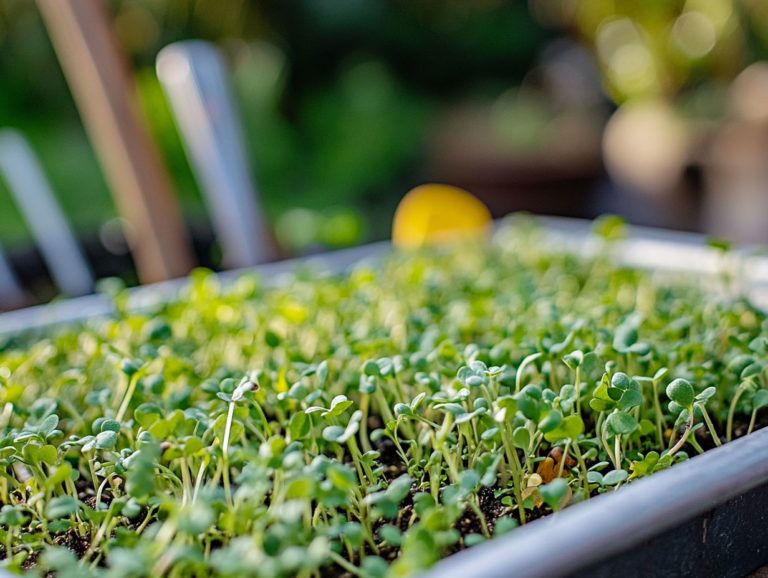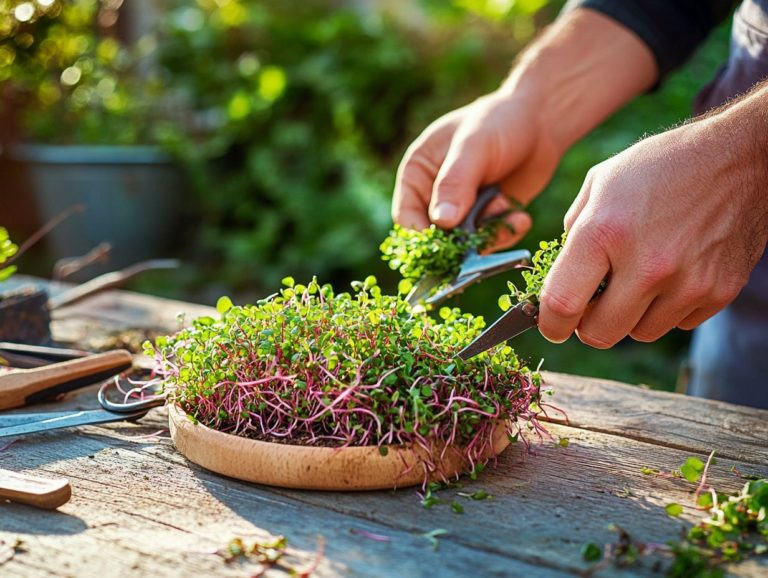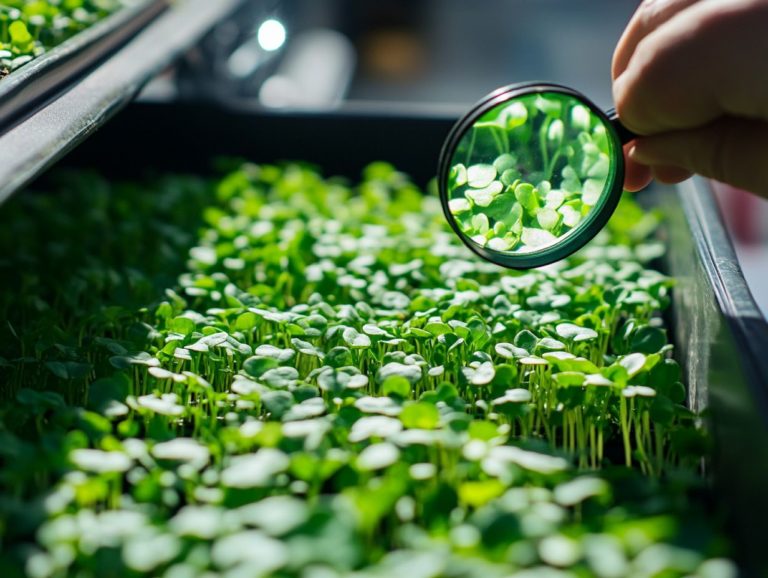How to Properly Harvest Microgreens for Maximum Flavor
Microgreens are tiny plants packed with nutrients. They add vibrant flavors and stunning colors to any dish. Mastering the art of harvesting these greens is crucial for maximizing their culinary potential.
This article provides everything you need to know about microgreens from their impressive nutritional benefits to the best timing for harvesting.
Discover effective techniques, storage tips, and common pitfalls to avoid. This ensures you maximize the flavor and freshness of your microgreens.
Contents
Key Takeaways:
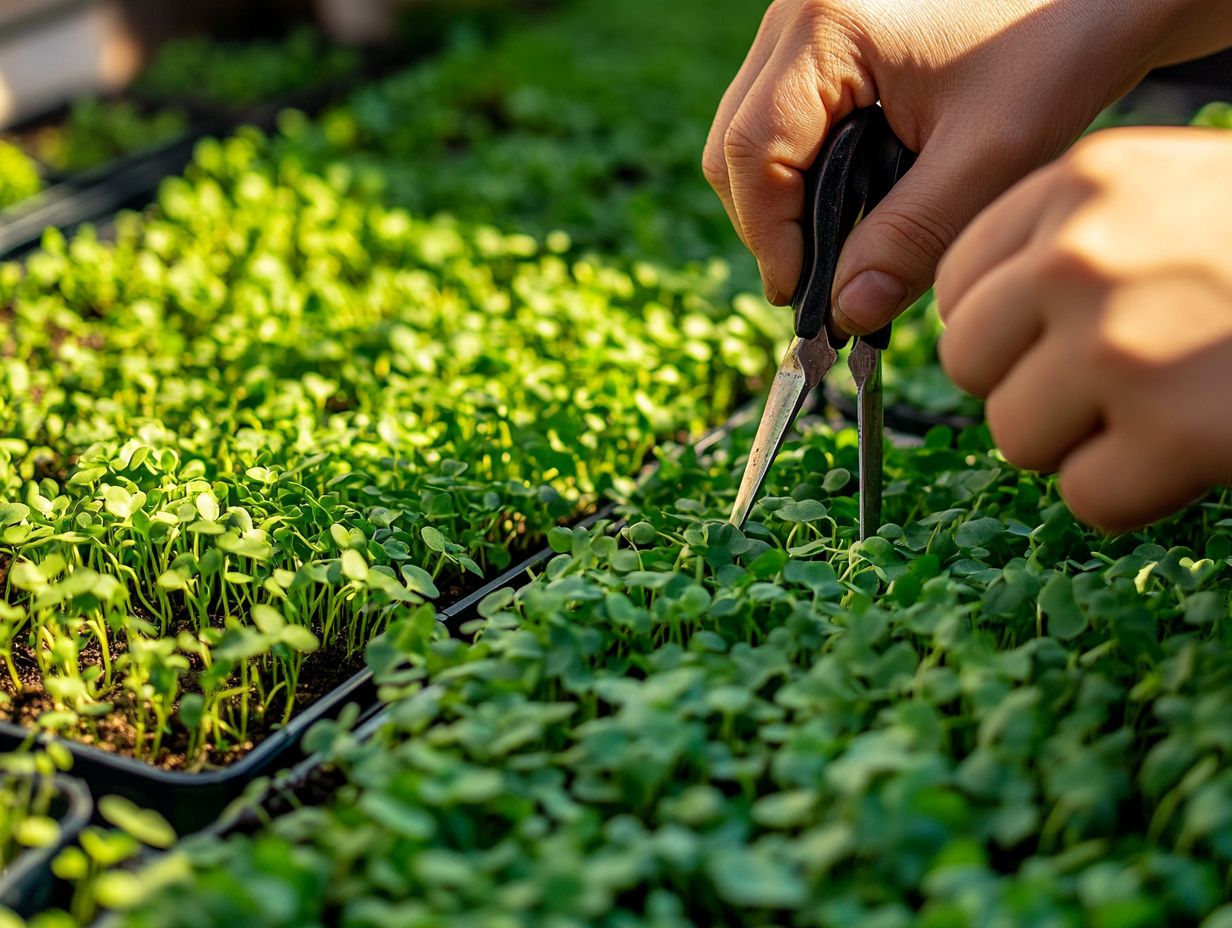
- Harvest microgreens at peak flavor.
- Use sharp scissors and handle gently.
- Store them cool and damp.
What are Microgreens?
Microgreens are young, edible plants harvested when they are just starting to grow. This stage offers the best flavors and nutrients. They are celebrated for their vibrant colors and intense flavors.
These nutrient-dense greens have surged in popularity among home gardeners due to their impressive nutritional value and health benefits. They are a staple in culinary applications, ranging from fresh salads to exquisite garnishes.
Their growth process involves delicate seeds sprouting into seedlings, nurtured for about 7 to 21 days, depending on the variety. Common choices include:
- Arugula, known for its peppery bite,
- Radish, which brings a crunchy zest,
- Broccoli, celebrated for its high vitamin content,
- Sunflower, valued for its nutty flavor,
- Pea Shoots, recognized for their sweet taste.
These microgreens not only enhance the visual appeal of dishes but also cater to health-conscious diners eager to enrich their meals with concentrated nutrients and flavors. Whether you incorporate them into a fresh salad, blend them into smoothies, or use them as a striking garnish on entr es, their versatility makes them a compelling addition to both home kitchens and upscale dining establishments.
Benefits of Harvesting Microgreens
Harvesting microgreens provides a wealth of advantages that extend far beyond mere flavor. These vibrant greens are brimming with essential nutrients and health benefits that can elevate any dish.
Whether you tend to a home garden or craft culinary masterpieces in a professional kitchen, understanding the nutritional value and distinct flavor profiles of different microgreen varieties will significantly enhance your meals.
Nutritional Value and Taste Benefits
Microgreens are more than just a garnish; they deliver a delightful burst of flavor and are packed with nutritional benefits. They often boast higher nutrient levels than their fully-grown counterparts. With their vibrant colors and optimal taste, they can effortlessly elevate a range of dishes, from simple salads to gourmet entrees.
Take radish microgreens, for example. They’re brimming with vitamins A, C, E, and K, along with a wealth of antioxidants that promote immune health and enhance skin vitality. Broccoli microgreens provide sulforaphane a compound renowned for its cancer-fighting properties.
Culinary enthusiasts often weave these tiny greens into an array of enticing recipes. Consider a zesty radish salad drizzled with lime vinaigrette or creamy avocado toast topped with sunflower microgreens for that extra crunch and nutrition. By harmonizing flavor with health benefits, microgreens are revolutionizing plate presentations and championing wellness, making them an essential ingredient in modern cuisine.
Choosing the Right Time to Harvest

Selecting the perfect moment to harvest microgreens is essential for maximizing their flavor and nutritional benefits. Pay close attention to the visual cues as they grow.
Key indicators like height, density, and leaf development will help you pinpoint the ideal time for harvest. This careful attention elevates the taste and enriches the nutritional value of your greens.
Factors to Consider
Several factors influence when to harvest microgreens. These include environmental conditions such as light, temperature, and soil quality.
Talking with others in the microgreens community can give you valuable tips. For instance, light exposure is crucial; ensuring your plants receive adequate sunlight or using grow lights promotes healthy growth and enhances flavor profiles.
Humidity levels, or the amount of moisture in the air, play a significant role in seed germination and overall vigor. Too much moisture can lead to mold, while too little can stunt growth.
Monitor these variables and document your observations. Sharing insights with fellow gardeners can lead to improved techniques and better yields.
Adjust your harvesting timeline based on these environmental factors. This way, you can maximize both the quantity and quality of your microgreens.
Proper Techniques for Harvesting Microgreens
Mastering the art of harvesting microgreens is crucial for maintaining their freshness, flavor, and nutritional integrity. Cut them at the optimal height and ensure they are washed and dried properly.
Tools and Methods for Harvesting
Using the right tools can enhance the quality of your greens. Start with a pair of sharp scissors for clean cuts and minimal damage.
Consider knives designed for harvesting to make quick and precise cuts. This can streamline your process.
Once you ve cut the microgreens, transfer them into food-grade containers to maintain their freshness and safety.
Don t overlook the benefits of composting leftover microgreens. This practice reduces waste and contributes to a more sustainable gardening ecosystem.
Storing and Using Harvested Microgreens
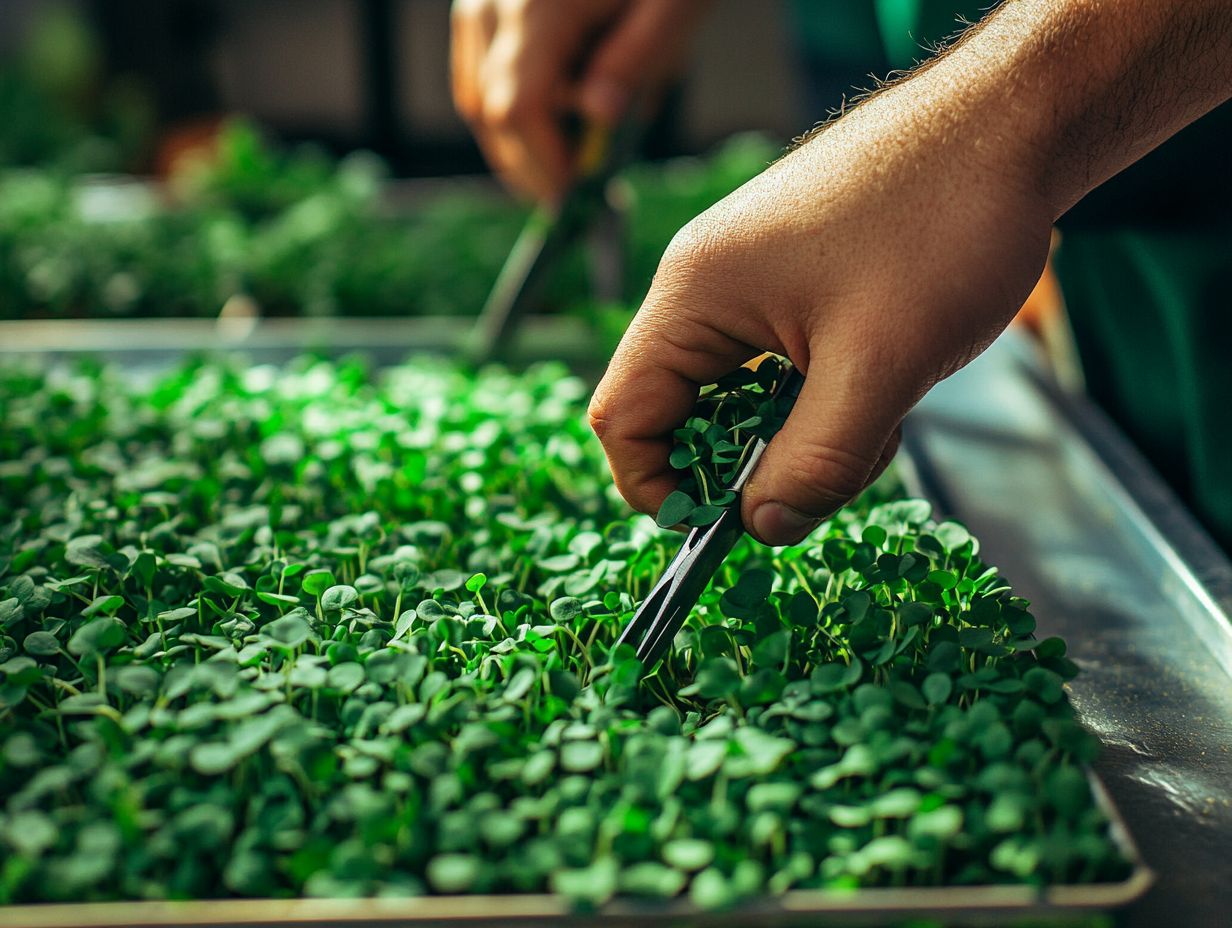
Proper storage methods for your harvested microgreens are essential. They preserve freshness and extend shelf life, elevating any meal they enhance.
By following best practices for storage, you can ensure that these nutrient-dense greens remain crisp and flavorful until you’re ready to enjoy them. Additionally, learning how to rotate crops for microgreens can enhance your growing techniques.
Top Tips to Keep Your Microgreens Fresh and Tasty
To truly maximize the shelf life and freshness of your harvested microgreens, embracing best practices for storage and consumption is crucial. Selecting the right storage containers will help maintain their vibrant colors and optimal flavor. This allows you to savor their culinary potential for as long as possible.
Using breathable containers, like plastic bags with holes for air to escape or clamshells, can significantly enhance the longevity of microgreens. These options allow moisture to escape while still protecting against wilting. For more tips, including timing your microgreens: when to harvest, glass jars can also serve as an excellent alternative, especially when lined with a damp paper towel to maintain humidity without risking rot.
Don’t underestimate these small greens; they can transform your meals! Their unique flavors can elevate salads, sandwiches, and even soups, inviting you to explore their full potential in your home kitchen. For those interested in cultivating their own, a step-by-step guide to sowing microgreens can be incredibly helpful. By mastering proper storage methods, you can effortlessly incorporate microgreens into your dishes and enjoy their nutritional benefits over an extended period.
Common Mistakes to Avoid
Understanding the common mistakes in harvesting and storing microgreens is crucial for preserving their vibrant flavor and freshness. This knowledge not only helps prevent spoilage but also ensures you retain their health benefits and culinary allure.
By engaging with the microgreens community, you can gain valuable insights to sidestep pitfalls, such as improper washing and drying techniques, while also learning watering techniques for thriving microgreens that can compromise quality.
Preventing Flavor Loss and Spoilage
Preventing flavor loss and spoilage in microgreens is essential for preserving their distinct flavor profiles and nutritional value, enhancing the quality of your meals. By implementing effective storage practices, you can significantly boost the overall freshness of your microgreens and extend their shelf life.
To achieve this, handle these delicate greens with care. Avoid bruising or damaging them during harvest and transportation. Refrigerating microgreens immediately after purchase or harvesting will help maintain their crispness and taste. Using breathable containers can prevent moisture buildup, which is a common culprit of spoilage. For optimal growth, understanding the perfect light conditions for microgreens is essential. Regularly check for wilted or yellowed leaves and promptly remove them to keep the remaining greens fresher for longer.
By ensuring optimal storage conditions, you can genuinely savor the incredible flavors and health benefits that well-kept microgreens bring to your culinary creations.
Watch this video for tips on harvesting and storing microgreens effectively.
Frequently Asked Questions

What are microgreens?
Microgreens are young vegetable greens harvested just a few weeks after germination. They are packed with nutrients and have a delicate, flavorful taste.
Why is it important to properly harvest microgreens?
Properly harvesting microgreens ensures you get maximum flavor and nutrition from your greens. Improper harvesting can damage the delicate plants and affect their taste and texture.
When is the best time to harvest microgreens?
The best time to harvest microgreens is when they have reached the desired size, usually around 7-14 days after germination. This is when they are at their peak flavor and nutrition.
How do I know when my microgreens are ready to be harvested?
Microgreens are ready to be harvested when they have developed their first true leaves and are about 2-3 inches tall. You can also check the seed packet or variety information for specific harvesting guidelines.
What is the proper technique for harvesting microgreens?
The proper technique for harvesting microgreens is to use clean scissors or a sharp knife to cut the plants just above the soil line. It is important to avoid pulling or yanking the plants, as this can damage the roots and affect future growth.
Can I store harvested microgreens?
Yes, you can store harvested microgreens in the refrigerator for up to a week. It is best to place them in a sealed container or bag with a damp paper towel to help keep them fresh.
Ready to grow your own microgreens? Start your adventure today!



